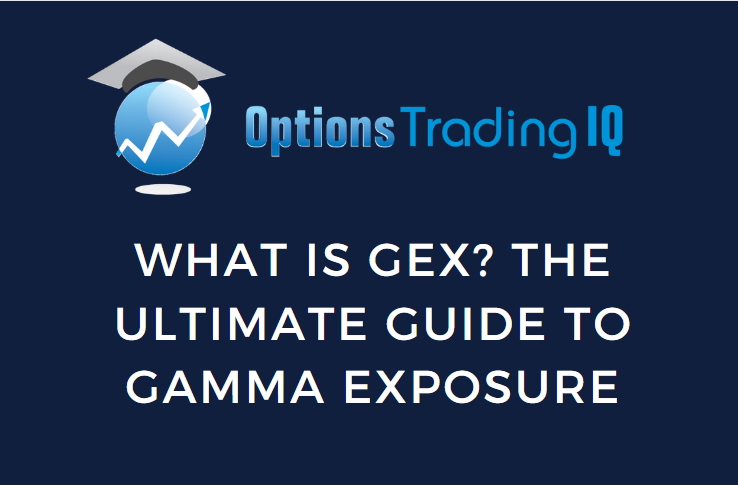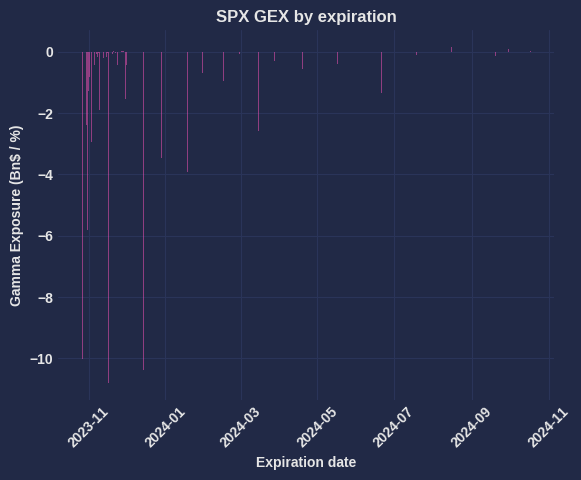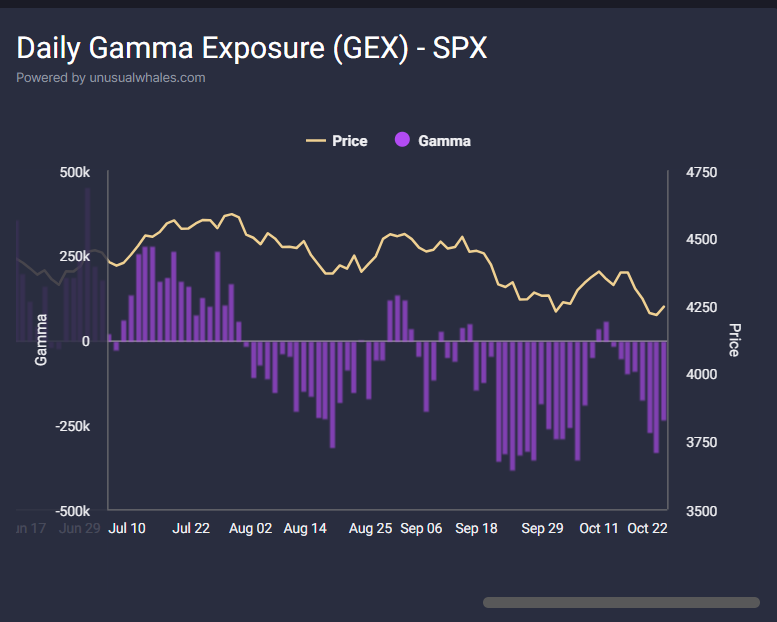

What is GEX?
GEX or Gamma exposure, is a critical concept in the world of options trading, holding the key to understanding how market participants react to price movements.
In this article, we delve into the fundamentals of GEX and its implications for navigating the derivatives market with confidence.
Contents
What Is GEX (Gamma Exposure)?
Gamma exposure, commonly called GEX, measures the change in delta exposure for options based on a 1% change in the underlying price.
Delta exposure represents the option market’s directional exposure to the underlying asset.
GEX looks to quantify the rate of change in delta exposure across all options for a particular asset.
It provides insights into how much volatility the options market can absorb from price changes.
GEX is calculated by taking the change in the total delta exposure for a 1% hypothetical move up and down in the underlying price.
See below for an example:
– Current SPY Price: $100
– Total Delta if SPY moves 1% down to $99: -5,000
– Total Delta if SPY moves 1% up to $101: +7,000
– GEX = Change in Delta / 1% move = (7,000 – -5,000) / 1 = 12,000
The higher the GEX value, the more sensitive the options are to rapid price movements.
GEX shows how much leveraged directional exposure exists across all strikes and expirations.
It helps gauge whether a swift move in either direction could overwhelm the options market-making capacity.
This has happened several times recently in Gamma Squeeze events.
Long Gamma vs. Short Gamma
In retail trading, an individual’s gamma position refers to whether you are long or short gamma, which has implications for how the trades will be impacted by volatility.
Long Gamma Position
A long or positive gamma position typically occurs when a trader owns the options, either calls or puts.
Long gamma positions benefit from increasing volatility, and as a result, this usually has a positive impact on price.
Think of it this way: with increasing volatility, there is a higher likelihood an option could end up in the money, which makes it more valuable.
Short Gamma Position
A short or negative gamma position typically occurs when a trader sells or writes options.
Short gamma trades benefit from either stagnant or decreasing volatility.
Conversely to the long gamma trade above, as volatility decreases, so do the odds of a contract ending up in the money; this eats away at the premium and benefits an option writer.
Tracking Gamma Positioning
So, how do you track gamma positioning?
One way is to analyze the open interest of options at various strike prices.
This can give traders an estimation of the net gamma positioning of the overall options market.
Gamma exposure can be calculated using various free scripts and sites on the internet.
However, various paid tools exist that will automatically track the GEX positioning.
The graph to the left is a free script that can be run locally in Python with free data. Let’s take a look at what this positioning can mean.

If most open interest and gamma are concentrated in out-of-the-money call options, it indicates more positive gamma positioning.
This means the delta will increase rapidly if the underlying price rises.
Traders can use this analysis to anticipate that a move up may accelerate as dealers become shorter gamma and need to hedge their positions by buying more of the underlying.
Analyzing the shape of the gamma exposure across strikes allows traders to estimate where gamma may flip from positive to negative.
This area, known as the gamma flip point, indicates the price where volatility expansion may turn into volatility contraction.
Monitoring the gamma positioning and flip point can give key insights into potential future volatility.
Gamma’s Impact On Volatility
Gamma exposure has a direct effect on implied volatility in the markets.
As gamma exposure increases, it can correlate with increased market volatility.
This is because high gamma means options are more sensitive to changes in the underlying asset price.
Smaller price movements can trigger larger reactions from options, leading to bigger swings in the overall markets due to dealer/market maker adjusting.
When many options are clustered around a particular strike price, it creates concentrated pockets of gamma risk.
As the underlying asset approaches these gamma strike zones, it can trigger rapid expansions in implied volatility due to hedging or market maker unwinding; this phenomenon is known as a ‘Gamma Squeeze.’
Vanna And Charm Exposures
Vanna and charm are two Greek metrics related to gamma that can also impact volatility. Here’s a quick overview of each:
Vanna
Vanna measures the rate of change of delta relative to changes in the underlying implied volatility.
In other words, it shows how much delta changes as the implied volatility changes.
This property makes Vanna a second derivative of price since it measures the rate of change of delta.
A high positive Vanna can magnify volatility expansion on upside price swings, and a high negative Vanna can expand volatility on downside swings.
What is Charm?
Charm is a slightly less complicated concept.
This Greek measures the time decay value of delta, so how much delta will change as time passes and the price stays stagnant.
These two second-order Greeks are only really important on a conceptual level unless you plan on trading gamma or want to get into algorithmic trading.
The Future Of Gamma Trading
The Gamma metric has exploded in popularity in recent years, as many tools have become available for retail traders, and volatility spikes have become more frequent.
This popularity can be a double-edged sword.
While it is becoming easier for retail traders and investors to utilize gamma in their trading, it also means that the edge is slowly (or not so slowly) disappearing as its use becomes normalized and accepted by everyday investors.
One of the events that may help keep gamma as a relevant trading tool, at least in the short term, is the addition of Weekly and Daily options on more and more instruments.
These will continue to skew Gamma readings and produce opportunities for traders until they become normalized.
To really help stay ahead of the curve on gamma and its uses, traders should look to quantitative and academic papers for the most cutting-edge research.
Drawbacks Of Gamma
While gamma exposure can provide useful signals, like every tool, there are some potential Drawbacks.
Oversimplification – Retail traders run the risk of oversimplification of this metric. GEX provides an aggregate snapshot of gamma positioning. However, it does not show the nuanced details of specific strikes and expirations. It is also constantly updated intraday with new opening and closing trades. This makes it difficult to stay up to date on exactly what is happening in the live market.
Not a Trading System – Besides oversimplification, GEX is not a standalone trading system. It is a source of market data that can be used to inform trading decisions, but relying solely on GEX to trade could be problematic.
Data limitations – Retail traders do not have a complete picture of gamma positioning from all market participants. While many tools are amazing, they are all still very accurate estimations.
Constantly Changing – Gamma exposure shifts rapidly with price movements. Historical GEX levels provide little guidance on current risks. Traders must stay nimble, especially after large price movements.
Interpreting Gamma Charts
Gamma charts visualize the aggregate gamma exposure for an index or stock over time. They allow traders to quickly identify areas where gamma is increasing or decreasing.
There are a few key things to look for on a gamma chart.
We will use the below GEX chart on the SPX as an example.
This chart comes courtesy of Unusalwhales.
Gamma Levels
– Higher gamma levels indicate increased sensitivity to price changes.
A gamma of 0.05 means a 1% move in the underlying price will impact options prices by 5%.
– Lower gamma levels around 0.01-0.02 are more stable.
But lower gamma means less protection against big, fast price swings.

Gamma Flip Regions
– Danger zones are areas where gamma flips from positive to negative or vice versa.
– A positive to negative gamma flip may trigger stop losses on a downward price move.
– A negative to positive flip could mean a squeeze up as market makers hedge.
Gamma Around Expiration
As options approach expiration, gamma exposure can change dramatically and affect pricing and volatility noticeably.
Here’s what traders need to know:
Gamma exponentially increases as options get closer to expiration.
This is because there are fewer days left for the underlying price to potentially move, so delta changes happen faster per unit of price change.
This “gamma ramp” effect causes rapid changes in the delta and increases sensitivity to the underlying price as expiration nears.
Small price movements can trigger huge swings in options pricing.
Be aware of expirations with large open interest on key strikes.
The gamma unloading can cause a short squeeze or selloff as it declines.
This can be particularly important around large expiration dates like the quad witching Fridays.
Related Articles
How to Reduce Gamma on an Iron Condor
Understanding Options Gamma. How is it Calculated and What Does it Mean?
Is Your Option Strategy Long Gamma or Short Gamma
Gamma Hedging Guide
Scalping Gamma From Long Puts
TLT Gamma Scalp Example
Option Gamma Explained: a 5-Minute Tutorial
Long Gamma and Short Gamma Explained
Gamma Risk Explained
Wrapping It Up
Gamma can be a very powerful addition to a retail trader’s toolbox.
While Gamma/GEX is not a standalone system, the information it can provide can save a trader from entering or exiting at potentially poor values.
As it becomes more mainstream, the quantity and quality of the available tools will continue to increase, but this is a double-edged sword because it also means the edge it provides will continue to erode.
Overall, Gamma Exposure is a piece of vital trading information that traders should consider adding to their trading routine.
We hope you enjoyed this article on what is GEX.
If you have any questions, please send an email or leave a comment below.
Trade safe!
Disclaimer: The information above is for educational purposes only and should not be treated as investment advice. The strategy presented would not be suitable for investors who are not familiar with exchange traded options. Any readers interested in this strategy should do their own research and seek advice from a licensed financial adviser.











Interested in the referenced script.
“The graph to the left is a free script that can be run locally in Python with free data. Let’s take a look at what this positioning can mean.”
Can you provide it? Thanks in advance.
Hi Darrell, this should be enough to get you started – https://github.com/joeyg6393/gex-tracker
Did you actually mean “Vanna is the rate of change of delta for 1% change in implied volatility” rather than “change in underlying price”?
Do you know of any similar scripts measuring VEX (vanna exposure)?
Thank you
Yes, well spotted. I have fixed that now.
This is interesting, thank you. Based on the code to access free data, the calculated GEX is gamma*openInterest*spot which will always be positive. Ideally, we want to find the gamma exposure of only market makers (since they are the most likely to delta hedge their positions) which could be positive or negative. Have you done any tests to determine if your your estimate of GEX correlates with the GEX of market makers?